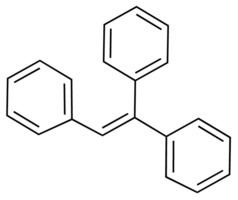CAS Number 58-72-0 ChemSpider 5803 3D model (Jmol) Interactive image | PubChem CID 6025 Formula C20H16 Molar mass 256.341 g/mol | |
 | ||
Triphenylethylene (TPE) is a simple aromatic hydrocarbon that possesses weak estrogenic activity. Its estrogenic effects were discovered in 1937. TPE was derived from structural modification of the more potent estrogen diethylstilbestrol, which is a member of the stilbestrol group of non-steroidal estrogens.
TPE is the parent compound of a group of non-steroidal estrogen receptor ligands. It includes the estrogens chlorotrianisene, estrobin (DBE), triphenylbromoethylene, triphenylchloroethylene, triphenyliodoethylene, triphenylmethylethylene; the selective estrogen receptor modulators (SERMs) afimoxifene, brilanestrant, broparestrol, clomifene, clomifenoxide, droloxifene, endoxifen, etacstil, fispemifene, idoxifene, miproxifene, miproxifene phosphate, nafoxidine, ospemifene, and toremifene. The antiestrogen ethamoxytriphetol (MER-25) is also closely related, but is technically not a derivative of TPE and is instead a triphenylethanol derivative. The tamoxifen metabolite and aromatase inhibitor norendoxifen is also a TPE derivative. In addition to their estrogenic activity, various TPE derivatives like tamoxifen and clomifene have been found to act as protein kinase C inhibitors.
